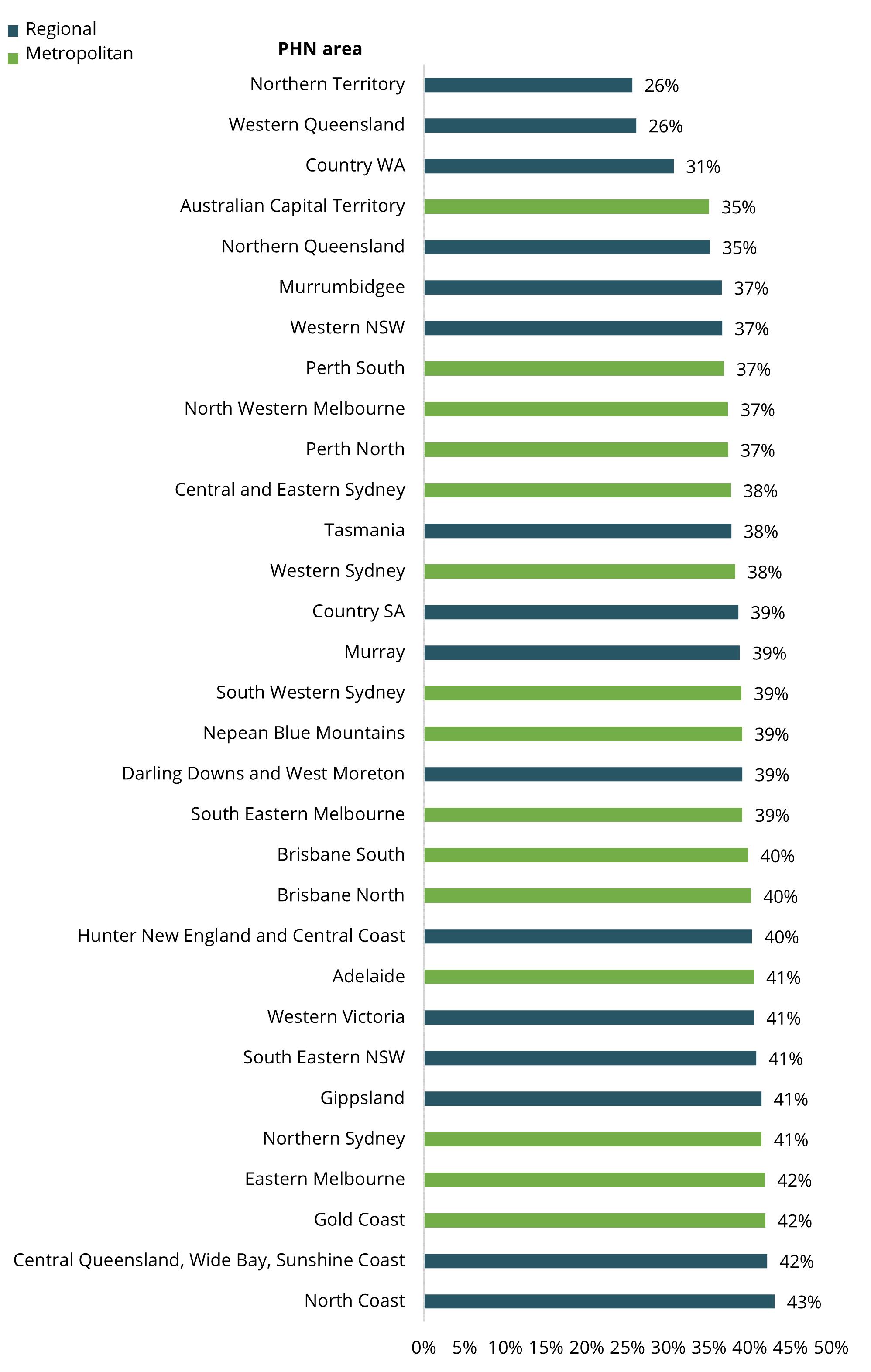Allied health services
Allied health services include a broad range of services delivered by health practitioners who are not doctors, nurses or dentists. Medicare-subsidised allied health services do not cover all allied health treatments. Allied health services are also accessed and funded through many arrangements, such as those subsidised by private health insurance or the Department of Veterans’ Affairs.
Over 10 million people (39% of Australians) received a Medicare-subsidised allied health service in 2022–23 (more than 26 million allied health services); a slight increase from 37% in 2018–19 (Table 4). In the same period, the number of services rose from 96 to 102 per 100 people.
The majority of the allied health services subsidised by Medicare are for optometry services, and the increase in the number of services was driven predominantly by an increasing proportion of people who had Medicare-subsidised optometry services (Table 4). Medicare-subsidised optometry service usage is driven by a number of factors including the broad eligibility for Medicare-subsidised eye examinations in Australia without the need for a referral, see the Optometry section of this report for more information.
Service groups(b) | 2018–19 (%) | 2022–23 (%) |
|---|---|---|
Allied health services(c)(d) | 37 | 39 |
Optometry(c) | 30 | 32 |
Mental health care(c)(e) | 5.3 | 5.0 |
Clinical Psychologist | 2.2 | 2.0 |
Other Psychologist | 2.9 | 2.7 |
Other Allied Mental Health | 0.4 | 0.4 |
Physical health care(c)(f) | 4.7 | 5.1 |
Physiotherapy | 3.4 | 3.7 |
Exercise Physiology | 0.7 | 0.6 |
Chiropractic Services | 0.6 | 0.7 |
Osteopathy | 0.3 | 0.4 |
Allied health – Other(c)(g) | 5.8 | 5.8 |
Podiatry | 4.5 | 4.6 |
Dietetics | 1.1 | 0.9 |
Occupational Therapy | 0.1 | 0.1 |
Speech Pathology | 0.2 | 0.1 |
Diabetes Education | 0.3 | 0.3 |
Audiology | 0.1 | 0.1 |
Other Allied Health | 0.1 | 0.2 |
Notes:
- Non-hospital Medicare-subsidised services only.
- Refer to Technical Information for details on MBS items and description of service groups.
- People may receive more than one subgroup service within Mental Health Care, Physical Health Care or Allied health – Other service groups, but will only be counted once in the total.
- Includes Optometry, Mental health care, Physical health care and Allied health – Other.
- Includes Clinical Psychologists, Other Psychologists and Other Allied Mental Health service groups.
- Includes Physiotherapy, Exercise Physiology, Chiropractic Services and Osteopathy service groups.
- Includes Podiatry, Dietetics, Occupational Therapy, Speech Pathology, Diabetes Education, Audiology and Other Allied Health.
Sources: AIHW analysis of Department of Health and Aged Care, MBS claims data; ABS ERP.
Box 4: What are Medicare-subsidised allied health services?
Allied health includes a broad range of services delivered by health practitioners who are not doctors, nurses or dentists. This includes audiologists, chiropractors, occupational therapists, optometrists, osteopaths, physiotherapists, podiatrists, psychologists and speech pathologists (AHPA 2023). Australians eligible for Medicare-subsidised allied health services can use allied health services through many channels, including Medicare, general private health insurance (‘ancillary’ or ‘extras’ cover), or by paying for the service entirely out-of-pocket. At present, there is no national data on allied health service use outside of Medicare or private health insurance (AIHW 2018).
Who is eligible for Medicare-subsidised allied health services?
Medicare-subsidised allied health services account for only a portion of all allied health service use in Australia, and, with the exception of optometry services, are generally only available to people who are referred by a GP, or in some cases a specialist medical practitioner. Common referral pathways include GP Mental Health Treatment Plans for people with a mental health condition and GP Chronic Disease Management Plans for people with a chronic health condition (in this report these are referred to as Enhanced Primary Care GP attendances). For more detail, refer to the Technical Information for this release.
Younger Australians were more likely to see a psychologist or allied mental health care worker
In 2022–23, younger Australians were more likely to see a Medicare-subsidised psychologist or allied mental health care worker than those aged 65 and above. The most common age groups to see these health professionals were those aged 15–24 (7.9%) and 25–44 years (7.2%), compared to only 2.3% for those aged 65–79 and 0.9% of people aged 80 and over).
Medicare-subsidised allied health service use varied across PHN areas
The proportion of Medicare-subsidised allied health services used appear similar for regional and metropolitan Primary Health Networks (PHN), both being 39%. However, there is a considerable range of variation in regional PHNs from 26% in Northern Territory and Western Queensland PHNs to 43% in North Coast PHN as well as variation in metropolitan PHNs from 35% in Australian Capital Territory PHN to 42% Eastern Melbourne and Gold Coast PHNs (Figure 6).
Figure 6: Percentage of people who had a Medicare-subsidised allied health service, by PHN area, 2022–23

Chart: AIHW.
Sources: AIHW analysis of Department of Health and Aged Care, MBS claims data; ABS ERP.
AHPA (Allied Health Professions Australia) 2023. What is allied health. Melbourne: AHPA. Viewed 8 January 2024.
AIHW (Australian Institute of Health and Welfare) 2018. Australia’s health 2018. Australia’s health series no. 16. AUS 221. Canberra: AIHW. Viewed 8 January 2024.


